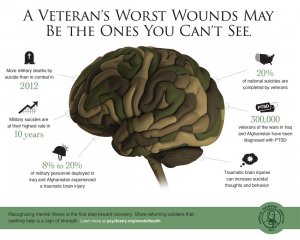Veteran PTSD, also known as an “invisible wound of war”, is a very serious problem. Affecting as many as 1 in 5 of veterans from Afghanistan and 1 in 8 of veterans from Iraq, Veteran PTSD claims the lives of as many as 22 US Veterans a day through suicide. That is an astounding number of people dying every day who had ironically already given their lives up at least once to serve the very country that fails to help them effectively. There is not enough staffing or funding to help these poor men and women the way they should be helped. Too many of these Veterans suffering from PTSD find themselves jobless, homeless, and addicted to drugs because they are being left behind.
Our lonely society makes it hard to come home from war | Sebastian Junger

What are some signs and symptoms of Veteran PTSD?
Nightmares or night terrors
Flashbacks
Depression
Feeling lost
Losing interest in things you once loved
Rage or unwarranted anger
Branden gets help with PTSD
Just like any other mental illness, having predispositions like a family history of PTSD or depression makes one more likely to suffer from it themselves. Knowing your family history is a great way to get started with treating PTSD. It could be a lifelong battle, but having support is crucial in the healing process.
8 Things you should know about Veteran PTSD
Most American civilians will never be exposed to or witness the types of violence and violence-related death as the men and women who served this county overseas. It is imperative non-military civilians not only appreciate, but understand the sacrifice our Veterans made for this country. Some of them carry lifelong invisible battle wounds that will only heal with time and acceptance.
References
Video 1
Our lonely society makes it hard to come home from war | Sebastian Junger
Video 2
Branden gets help with PTSD
Video 3
8 Things you should know about Veteran PTSD
Mattson, E., James, L., & Engdahl, B. (2018). Personality Factors and Their Impact on PTSD and Post- traumatic Growth is Mediated by Coping Style Among OIF/OEF Veterans. Military Medicine, 183(9/10), e475–e480. https://doi.org/10.1093/milmed/usx201
MCGRATH, P. B. (2018). Virtual Reality Therapy Helps Ease Veterans’ PTSD. Health Progress, 99(4), 26– 29.
Morland, L. A., Wells, S. Y., Glassman, L. H., Grubbs, K. M., Mackintosh, M.-A., Golshan, S., Sohn, M. J., Thorp, S. R., Savage, U. C., & Acierno, R. E. (2019). What Do Veterans Want? Understanding Veterans’ Preferences for PTSD Treatment Delivery. Military Medicine, 184(11/12), 686–692. https://doi.org/10.1093/milmed/usz035

I enjoyed the statistics provided at the beginning. It allowed me with a better picture of how many Veterans are affected by PTSD, which is a WHOLE lot more than I would’ve imagined. You’ve made a great point, more resources should be provided to veterans who have risked their lives for our country. They’ve witnessed many horrific, traumatizing events that now affect their daily lives. Veterans should be supported and should be showed endless appreciation at least by helping them when they’re in need like you’ve stated. Thank you for speaking up for Veterans and PTSD, I learned a lot from your blog!
This is such an important topic, especially right now. Veterans have sacrificed so much for our country, there care should always be a prioirity.